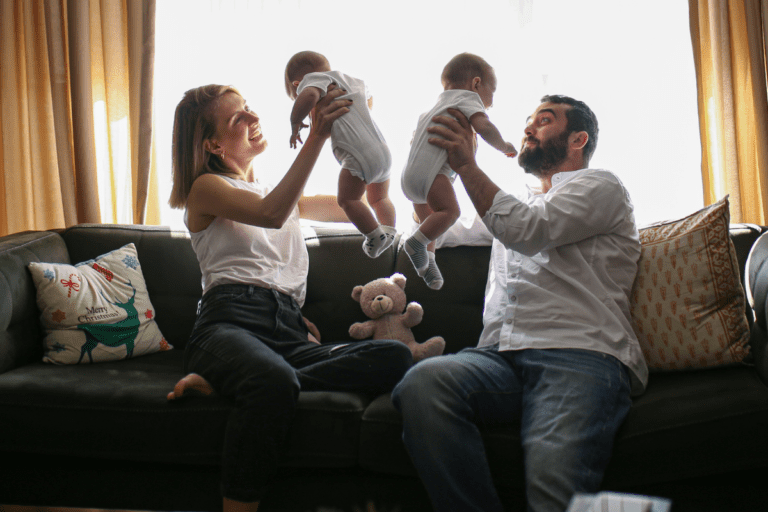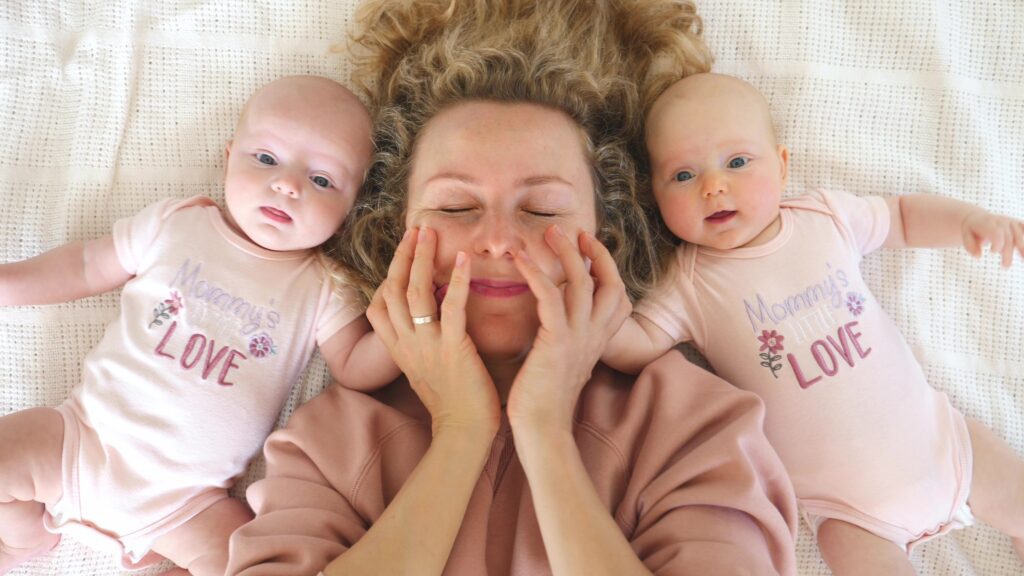Sleep Strategies for Multiples
If you are expecting twins or are already a mom of multiples, this blog post is dedicated to you. Motherhood is a whirlwind of emotions and a balancing act, juggling your little one’s needs and in this case, both of your babies’ needs. I’m going to talk through some sleep strategies to help you with your multiples.

Adjusted Age
One of the most important things I stress with families about sleep is to follow awake windows. The awake window is the amount of time awake your baby can handle before they need more sleep. Pushing your baby past this window will result in overtiredness and a fussy, cranky baby.
Unsure of the appropriate awake window for your babies? Download my free resource, Awake Windows Guide.
Multiples are often born premature and therefore awake windows should be measured on baby’s adjusted age (e.g. born at 35 weeks, adjust age by 5 weeks). If you’re unsure about your baby’s adjusted age, ask your pediatrician. Some doctors consider babies full term after 37 weeks, so the adjusted age may vary.
30 Minutes Apart
Keep both babies on the same schedule for sleep, within 30 minutes of each other. This means you should wake Baby B no later than 30 minutes from when Baby A wakes up. When it comes to naptime lay Baby A down before Baby B since Baby A has been awake longer.
Try to feed both babies on the same schedule as well if you have help. Otherwise feed Baby A upon waking and then when Baby A is done eating wake up Baby B and feed them. If you are breastfeeding you may find it easier to nurse one baby at a time until you get the latch and positioning down. Then it will be easier to nurse both babies together.
I recommend following an Eat – Play – Sleep schedule so you’re feeding baby upon waking versus right before sleep. This helps your babies stay awake for the entire feeding and take full feedings. Preemies and newborns will naturally be sleepier and tougher to keep awake, that will improve after a few weeks.
Feedings should take about 20-30 minutes for most babies. Remember your babies can’t handle a lot of awake time so try to keep in mind that after a diaper change, feeding and some play time it’s back to sleep.
When it comes to nighttime, you will probably have 1 baby that wakes up sooner than the other, that’s normal. Unless the doctor has advised to wake up baby for feedings, let the other baby sleep and wake up on their own for feedings.

Wait Before Responding
Perhaps one of the biggest fears with multiples and sleep (especially when in the same room) is that one baby is going to wake the other. Well, I’m here to tell you that it’s going to happen at some point, there’s no avoiding it altogether.
So when you hear one of your babies cry out in the night try to wait a few minutes before responding to make sure they’re truly awake. Even if they wake up their sibling, you want to make sure your baby is truly awake before running in.
All babies cycle through stages of sleep and can cry out in between sleep cycles. Waiting a few minutes will help make sure they’re awake and not just resettling. It can be helpful to have a sound machine for each child to help mask the noise from their sibling, which takes me to the next tip.
Same or Separate Room?
Now for the most popular question, should you keep your babies in the same room or separate them for sleep? Honestly, you can achieve good sleep either way. If your goal is to keep both babies in the same room, keep them together for nighttime sleep from the newborn stage on.
If you’re past the newborn stage and decide to sleep train your multiples you’ll find it easier to separate them initially while they are learning to sleep independently. I recommend moving the better sleeper to a pack and play in another room or a walk-in closet or bathroom for nighttime and naps. The Slumberpod is also an amazing option if one baby has to room share with you or you need a dark sleep space.
There’s usually one baby that seems more easy going and adaptable so that twin should be moved out and let the more challenging sleeper stay in the room. Once they’re both falling asleep pretty quickly (under 15 minutes) with minimal fussing you can move both babies back together for nighttime.
Naps tend to be more challenging so it’s more imperative they’re separated for naps if not achievable at nighttime. It can take longer for your baby to fall asleep at naptime plus naps really vary in length and one baby can easily wake up the other. As mentioned above try keeping both babies within 30 minutes of the other.

Last Tips and Reminders
If you find one twin falling asleep faster than the other one, try not to give extra help to the other baby so they’re both truly falling asleep independently. With time and consistency both babies will be falling asleep independently.
Plan for the bedtime routine to take a little longer than 30 minutes. Bath time is a great first step and then diaper changes and jammies. Hopefully you have some support at bedtime so you can divide and conquer, but that might not always be the case. If not, place one twin down in a bouncer or on a playmat while you feed the other baby and then switch. Having a nap routine is helpful as well, but much shorter. Something simple like a diaper change, sleep sack, song and into the crib awake.
Give yourself some grace, mama! Baby sleep can be challenging with one baby, let alone two or more! If you find yourself struggling with sleep and aren’t sure where to start, reach out! Book a free sleep solution call today and we can chat more about your sleep struggles and how a customized plan can help you.

